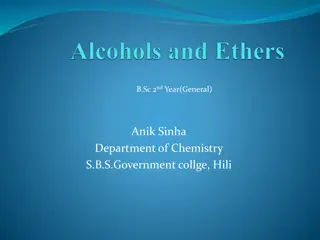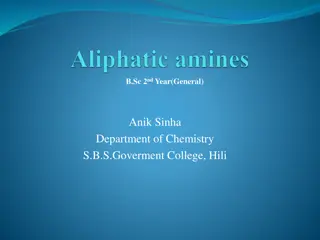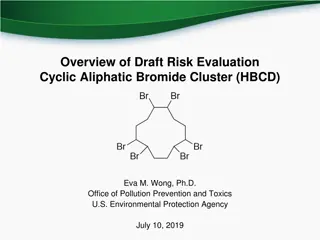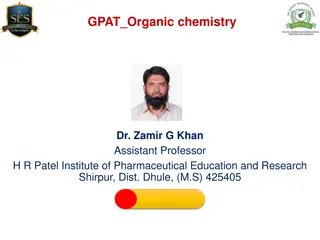Overview of Herbicides Classification and Groups
Herbicides are classified based on their chemical nature into inorganic and organic types. Inorganic herbicides, such as arsenic acid and copper sulfate, do not contain carbon atoms, while organic herbicides, like glyphosate and 2,4-D, contain carbon atoms. The classification includes various groups
4 views • 15 slides
Understanding Alcohols: Classification and Nomenclature
Alcohols are categorized into aliphatic and aromatic types based on the structure of the hydroxyl group. Aliphatic alcohols have the OH group attached to an aliphatic carbon chain, while aromatic alcohols have it in the side chain of an aromatic hydrocarbon. Further classification includes monohydri
0 views • 11 slides
Overview of Alcohols: Classification, Preparation, and Properties
Alcohols are compounds containing hydroxyl groups, classified based on chain type and number of hydroxyl groups. They can be aliphatic or aromatic, monohydric or polyhydric. Classification also includes primary, secondary, and tertiary alcohols based on carbon hybridization with the hydroxyl group.
1 views • 22 slides
Overview of Amines Synthesis and Reactions
This educational content delves into the classification and synthesis of amines, focusing on the synthesis of aliphatic amines through various methods like reduction of nitro compounds, acid amides, and aldoximes. It also discusses important reactions such as the Hofmann degradation, Curtius reactio
0 views • 19 slides
Comparison of Aliphatic and Aromatic Carboxylic Acids in Chemical Properties
The article explores the differences between aliphatic and aromatic carboxylic acids, detailing their properties, common uses in food and cosmetics, as well as their reactions in ignition tests. It discusses the appearance changes and odor variations upon ignition, along with the distinctive color f
0 views • 14 slides
Overview of Draft Risk Evaluation for Cyclic Aliphatic Bromide Cluster (HBCD)
The overview discusses the draft risk evaluation of the Cyclic Aliphatic Bromide Cluster (HBCD) conducted by Eva M. Wong, Ph.D., from the Office of Pollution Prevention and Toxics, U.S. Environmental Protection Agency. It covers sections on exposure, hazards, risk characterization, risk determinatio
0 views • 13 slides
Biochemistry and Chemistry Elective Courses Overview at SRCASW
The Shaheed Rajguru College of Applied Sciences for Women offers elective courses in Biochemistry and Chemistry. The Biochemistry course covers biomolecules like amino acids, proteins, carbohydrates, lipids, and nucleic acids, emphasizing their properties and functions. It also includes practical ex
0 views • 19 slides
Introduction to Aromatic Compounds and Benzene Nomenclature
Learn about aromatic compounds, their resonance in benzene, orbital structure, nomenclature for benzenes, and different types of substituents like monosubstituted and disubstituted benzenes. Explore the stability of aromatic compounds compared to aliphatic ones and understand the nomenclature for va
0 views • 19 slides







